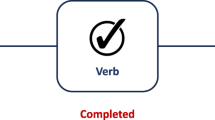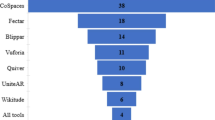Abstract
Technology-enhanced learning, employing novel forms of content representation and education service delivery by enhancing the visual perception of the real environment of the user, is favoured by proponents of educational inclusion for learners with physical disabilities. Such an augmented reality computer-mediated learning system has been developed as part of an EU funded research project, namely the CONNECT project. The CONNECT project brings together schools and science centres, and produces novel information and communication technologies based on augmented reality (AR) and web-based streaming and communication, in order to support learning in a variety of settings. The CONNECT AR interactive learning environment can assist users to better contextualize and reinforce their learning in school and in other settings where people learn (i.e. science centres and home). The CONNECT concept and associated technologies encourage users to visit science centres and perform experiments that are not possible in school. They can also build on these experiences back at school and at home with visual augmentations that they are communicated through web-based streaming technology. This paper particularly focuses on a user-centred evaluation approach of human factors and pedagogical aspects of the CONNECT system, as applied to a special needs user group. The main focus of the paper is on highlighting the human factors issues and challenges, in terms of wearability and technology acceptance, while elaborating on some qualitative aspects of the pedagogical effectiveness of the instructional medium that AR technology offers for this group of learners.






Similar content being viewed by others
Explore related subjects
Discover the latest articles, news and stories from top researchers in related subjects.Notes
Designing the classroom of tomorrow by using advanced technologies to connect formal and informal learning environments.
References
Tang S-L, Kwoh C-K, Teo M-Y, Sing NW, Ling KV (1998) Augmented reality systems for medical applications. IEEE Mag Engineering in Med Biol 17(3):49–58
Kaufmann H, Schmalstieg D (2003) Mathematics and geometry education with collaborative augmented reality. Comput Graph 27(3):339–345
Starner T, Mann S, Rhodes B, Levine J, Healey J, Kirsch D, Picard R, Pentland A (1997) Augmented reality through wearable computing. Presence 6:386–398
Feiner S, MacIntyre B, Haupt M, Solomon E (1993) Windows on the world: 2D windows for 3D augmented reality. In: Proceedings of the 6th annual ACM symposium on user interface software and technology (Atlanta, Georgia, United States). UIST ‘93. ACM Press, New York, 145–155
Sotiriou S, Anastopoulou S, Rosenfeld S, Aharoni O, Hofstein A, Bogner F, Sturm H, Hoeksema K (2006) Visualizing the invisible: the CONNECT approach for teaching science. In: The 6th IEEE international conference on advanced learning technologies (ICALT 2006), Kerkrade, The Netherlands, 5–7 July 2006
Bialo ER, Sivin-Kachala J (1996) The effectiveness of technology in schools: a summary of recent research. Sch Libr Media Q 25(1):51–57
Brown DJ, Kerr S, Wilson JR (1997) Virtual environments in special-needs education. Commun. ACM 40(8):72–75
Hill JR, HwaKoh M, Singleton ES, Song L (2004) Improving online learning: student perceptions of useful and challenging characteristics. Internet High Educ 7:59–70
Knight JF, Baber C (2004) Neck muscle activity and perceived pain and discomfort due to variations of head load and posture, Aviat Space Environ Med 75:123–131
Knight JF, Baber C (2007) Assessing the physical loading of wearable computers. Appl Ergon (in press)
Knight JF, Baber CA (2005) tool to assess the comfort of wearable computers, Hum Factors 47(1):77–91
Knight JF, Schwirtz A, Psomadelis F, Baber C, Bristow HW, Arvanitis TN (2005) The design of the SensVest. Personal Ubiquitous Comput 9:6–19
Knight JF, Williams DD, Arvanitis TN, Baber C, Sotiriou S, Anastopoulou S, Gargalakos M (2006). Assessing the wearability of wearable computers. In: Proceedings of the 10th international symposium on wearable computers – ISWC2006, IEEE, Montreaux, Switzerland, pp.75–82
Acknowledgments
The authors would like to thank the European Community under the Information Society Technologies (IST) programme of the 6th FP for RTD-Project CONNECT contract number IST-507844 for supporting the project.
Author information
Authors and Affiliations
Corresponding author
Rights and permissions
About this article
Cite this article
Arvanitis, T.N., Petrou, A., Knight, J.F. et al. Human factors and qualitative pedagogical evaluation of a mobile augmented reality system for science education used by learners with physical disabilities. Pers Ubiquit Comput 13, 243–250 (2009). https://doi.org/10.1007/s00779-007-0187-7
Received:
Accepted:
Published:
Issue Date:
DOI: https://doi.org/10.1007/s00779-007-0187-7




